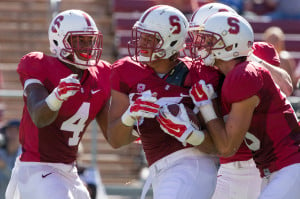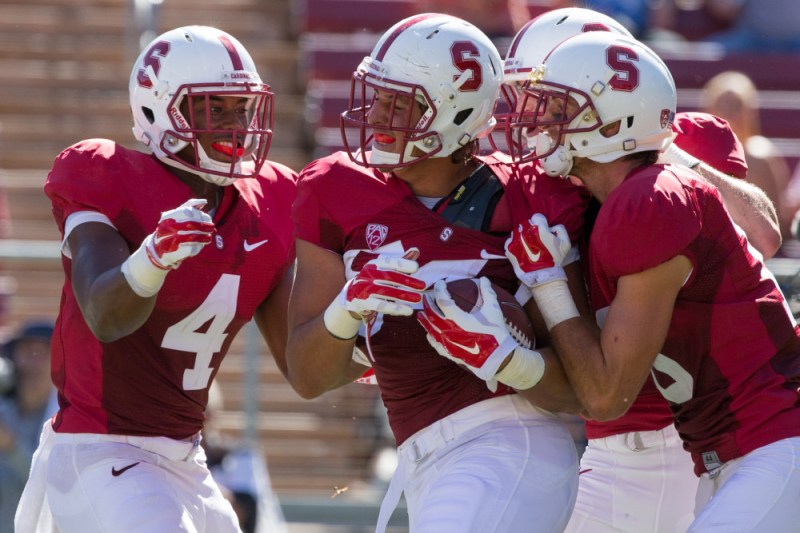In last season’s meeting between Stanford and USC, red-zone inefficiency plagued the Cardinal as they scored just one touchdown in four trips, coming up empty twice. We asked football writers Jordan Wallach, Vihan Lakshman and Joseph Beyda, what must Stanford do to flip the script and come away with touchdowns in the red zone against USC this time around? Is this year’s version of the Card better equipped to do that?
Jordan: Whether the team feels comfortable with it or not, much of the Cardinal’s successes or failures in the red zone this Saturday will rely on the right arm of senior quarterback Kevin Hogan. Stanford’s red zone offense will perhaps be the unit that suffers most from the loss of Tyler Gaffney ’14, as the downhill back accounted for 17 of the team’s 30 touchdowns within its opponents’ 20-yard line.

Head coach David Shaw went to Gaffney and the running game over five times more often than Hogan and the passing game in the red zone last season, a strategy that is likely to change in 2014 — at least in the early-going with the team’s committee of running backs that has yet to find its stride.
| 2013 Red Zone Offense | Passing | Rushing |
| Attempts | 13-for-18 (72 percent completion) | 96 |
| Yards Gained | 141 | 326 |
| TD | 7 | 21 |
Last season’s meeting at the Memorial Coliseum was one of worst games in Hogan’s career, perhaps understandably so considering the environment at the Memorial Coliseum that day. The 93,607 fans in attendance that day made up the biggest crowd Hogan had played in to that point in his career, with waving hands and “V’s” raining down from the USC student section.
Hosting the game at Stanford Stadium in front of the Cardinal faithful this weekend, albeit before most of the students arrive, will have a huge impact on Hogan and the team’s red zone efficiency as a whole. Just look at last season’s red-zone splits…
| 2013 Red Zone Splits | Home | Road/Neutral |
| Conversion Rate, with FCS rank | 100 percent (29-for-29), 1st | 78 percent (18-for-23), 82nd |
| TD-to-FG ratio | 19 TD / 10 FG | 11 TD / 7 FG |
Home field advantage will surely make decision-making a bit easier for Hogan in high-pressure situations, and the Cardinal — with 17 consecutive home victories, the longest streak in the nation — are certainly more equipped to capitalize on their red-zone opportunities this time around.
Vihan: Hogan is certainly a key piece in solving Stanford’s red zone puzzle, but, unlike Jordan, I don’t think the onus is solely on the senior signal-caller. For the Cardinal to improve on last year’s disappointing mark of only 30 touchdowns on 52 red-zone trips, head coach David Shaw must call plays that accentuate Stanford’s strengths and the offensive line must be effective at the line of scrimmage, especially against Leonard Williams and a stout Trojan defensive front.
From a play-calling standpoint, I’d like to see Stanford stay away from the Wildcat and the fade routes and instead rely more on consistently effective plays such as the read-option with Hogan. Last season, Stanford primarily used backup quarterback Dallas Lloyd for read-option plays with limited results even though Hogan had a lot of success running the same package. If Shaw can keep things simple and utilize his team’s strengths, especially by trusting Hogan’s legs and incorporating his young tight ends into the red zone offense, Stanford could turn some of those turnovers and field goals into touchdowns.
In the trenches, the Tunnel Workers’ Union will have to be on top of their game against USC, particularly junior guards Johnny Caspers and Josh Garnett. Primary running backs Kelsey Young and Barry Sanders both weigh under 200 pounds and likely won’t earn as many yards after contact as Gaffney. As a result, it will be crucial for Caspers and Garnett to dominate when they pull on power running plays and open up holes. Without a reliable presence on the ground, Stanford’s red zone effectiveness through the air will also take a hit.
As last year’s clash in the Coliseum showed, Stanford success in scoring touchdowns in the final 20 yards could determine the outcome of the game. On the other hand, if the Cardinal can keep generating explosive plays, maybe they won’t even need that pesky red zone.
Joseph: As Jordan and Vihan have both noted, Stanford’s aerial effectiveness with a short field suffered in 2013 — and not just against USC, either. Regardless, I think that problem is going to solve itself this season because of everybody’s favorite position on the Farm: tight ends.
I’m not sure it’s fair to compare sophomores Austin Hooper, Eric Cotton and Greg Taboada to the Tree Amigos of old after just one game. But boy, if they can be even mediocre doppelgangers on Saturday, the Trojans will have trouble stopping Stanford in the red zone.
Remember Levine Toilolo tiptoeing the corner of the end zone, Coby Fleener manhandling Tre Madden and Zach Ertz juking a USC defensive back? Ok, so the last one didn’t really happen in the red zone. But the point is that Stanford’s mismatches at tight end have consistently made a difference in this series, and if it wants to finish drives with six points, there are no better players to turn to than the Cardinal’s sophomore trio.
As The Daily’s tallest football writer, I like to talk about height a lot, so here goes. Hooper, Cotton and Taboada are 6-foot-4, 6-foot-6 and 6-foot-5, respectively. The oft-forgotten Charlie Hopkins lines up at 6-foot-6 as well. USC will start two 6-foot defensive backs, another who is 6-foot-1 and a fourth who is 5-foot-11. The Trojans’ tallest starting linebacker is 6-foot-2.
I rest my case.
Facing such height discrepancy against Stanford this weekend, USC tried to recruit 6-foot-5 Joseph Beyda in an attempt to find a solution for Stanford’s tight ends after watching him lock down both Jordan Wallach and Vihan Lakshman in street football outside The Daily’s offices. To contact Joseph or recruit him to your football team, contact him at jbeyda ‘at’ stanford.edu and to give Jordan and Vihan tips on how to beat tall defenders, contact them at jwallach ‘at’ stanford.edu and vihan ‘at’ stanford.edu.
